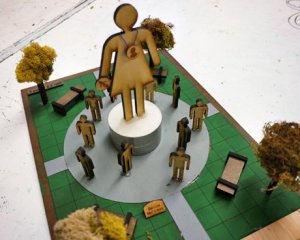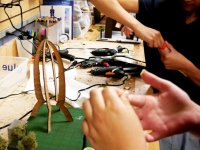Making (in) History: Learning by Reinvention
By incorporating making into the history curriculum, teachers can help students recognize that everything has history, and creatively engage them in reinventing that history.
The history classroom was a mess. There were wires, nails, brads, and wooden pieces on every desk, and students around me struggled with a difficult task. I knew that, in the middle of the mess, I had reached a good balance between student independence and teacher instruction, between hands-on experience and historical material, when one of my students looked up and said, "Mrs. Pang, this is fun! It's really hard, but it’s fun." She looked back down at the length of wire in her hands and kept winding it onto a large nail. She was following instructions to create the electromagnet on a telegraph machine. This student and her partner got theirs to work on the second try.
Through this small making project, they were exploring the history of innovation and communication. At the same time, they were learning about making electrical connections, how to use tools, and how to troubleshoot their work when it failed. And they said it was fun. In my mind, they were referring to Seymour Papert's kind of fun: hard fun.
While the introduction of FabLabs and makerspaces into schools tends to focus on the importance of hands-on projects in the STEM or STEAM fields, it's just as important that students engage in maker projects in their humanities and social science classes. History teachers should bring making into the classroom, even at schools that don't have formal makerspaces.
1. Everything Has History
Whatever topic students are interested in has a history, and that history links to something bigger. History is the original interdisciplinary subject. Thinking about the question of what people made during different eras gets at some fundamental parts of the human experience. It makes a difference when people invent things for everyday life, products or processes that change the food they eat, the clothes they wear, and the homes they live in. When people make new and extraordinary things, students can relate to these changes in the human experience.
This year, my students built basic working telegraph machines using parts that we prepared for them in our FabLab (to speed up the process). While they worked, they learned to use tools (wire strippers were difficult) and discussed the things that Samuel Morse would have needed to do in order to make his telegraph work. Students wrote short stories imagining 19th-century telegraph uses, and we had good discussions about the speed of communication and how it has changed from the Colonial era to the present.
2. Students as Creative, Engaged Designers
When students design and build, research and writing become meaningful for them. Our end-of-the-year maker project has student teams bringing their research to life by designing monuments to 20th-century women. They go through a shortened design thinking process, visualizing themselves as users, and thinking about monuments that they have seen or would like to visit. They argue for the women whom they'd like to represent in their monuments, and their creations reflect deep historical thinking as well as imagination and creativity. Although we do this project in our FabLab, there is no reason why it couldn't be done with more traditional classroom materials. Recycled cardboard is one of the best maker supplies around. (Visit our slideshow of Castilleja School's Monument Project.)

Students are designers and historians when they make movies, exhibits, websites, performances, and papers for National History Day. This national competition has students pick topics that they care about related to a unique theme. They research and design amazing projects every year.
3. Interdisciplinary Work and 21st-Century Skills
When students design their own projects, do their own research, and make in their history classes, they use material from all disciplines, and employ a wide range of skills. They are required to think critically and creatively, and to collaborate, problem solve, and communicate with their group and their classmates. I knew this when I started working on new maker projects. What I didn't expect was the math that I would be reviewing with every project. When you build and work in three dimensions, you need to understand scale. So I collaborated with math teachers to develop ways for me to help the students in my history class use and review the concepts they're learning in math class.
By incorporating making into the curriculum, teachers can stretch students to think more critically as they challenge them to become active designers of historical works, rather than simply consumers of other people's created histories. Making can require students to think about what important aspects of their subject they want to show, how literal or symbolic they want to be, and how to design the best user experience. All group projects require collaboration, but one of the benefits of building something physical, it turns out, is that it is much harder for a student to hide and let his or her classmates do all the work. And as the students tell me, making (in) history is fun.
How have you integrated making with social science or liberal arts curriculum? Please share your experiences below in the comments.
